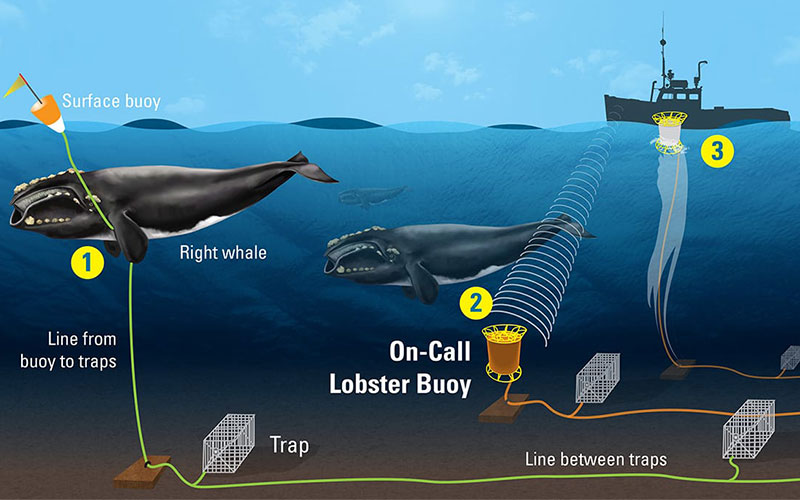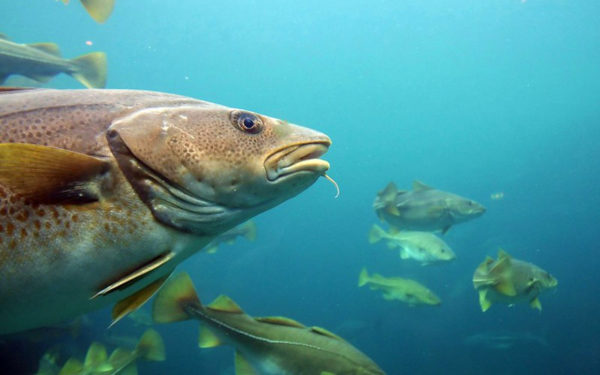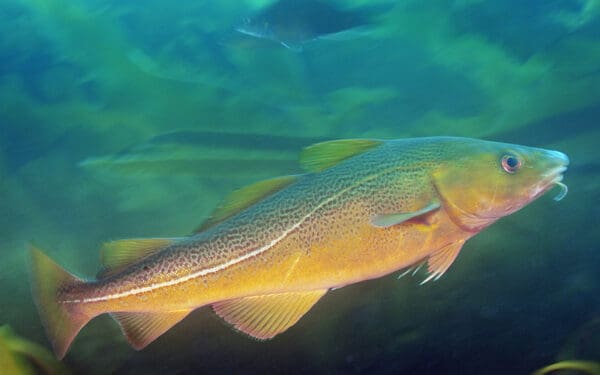
Ropeless gear would eliminate the biggest threat to right whales' survival, and the technology is ready today. Illustration by Eric Taylor, WHOI Graphic Services
Off the rocky coastline of Maine is an expanse of brightly colored lobster buoys. The buoys – which mark where potentially millions of traps are dropped along the 3,000-mile coast – are an iconic image, bobbing along with the shifting tides.
But lobsters aren’t the only living icon in Maine’s waters: The North Atlantic right whale makes its home here for part of the year, too. The right whale is one of the most endangered marine mammals on the planet, with only around 400 left on earth. And their struggle to survive is dire. This summer alone, at least eight whales have tragically died.
Strong, thick ropes connect Maine’s iconic buoys to lobster traps – and other trap and pot fishing gear – on the ocean floor. These ropes are the biggest threat to the whales’ survival. When whales dive through this maze, their mouths gaping to take in the plankton they rely on as food, there’s a good chance they’ll swim into a rope. In their panicked attempt to shake off the rope, they may end up entangling themselves further – twisting it around their bodies and sawing painfully into their skin – or worse drowning immediately.
But this threat can be removed. Ropeless gear, which eliminates the dangerous vertical lines, can help our iconic right whale and our iconic Maine fisheries survive.
How Ropeless Gear Works
Ropeless, or buoyless, gear has the potential to create a safer ocean for right whales. And the good news is, the technology necessary to retrieve devices off the bottom of the ocean floor has been around for decades. More recently, this technology has been used to retrieve fishing gear acoustically. There’s a range of ropeless gear technology in development that could offer a strong alternative to vertical lines in the water. Here’s how it works:
When a lobsterman wants to check their traps, rather than look for the surface buoy, they go to the area where the trap was dropped (marked by GPS) and send an acoustic signal down to the gear on the ocean floor. In response, either a guide rope brings a buoy to the surface or an inflatable raft brings the first trap to the surface. The rest of the time, there are no vertical lines in the water and no buoys floating at the surface. In an age where we can unlock our cars from across a parking lot or track our kids backpacking in Europe, this technology is not rocket science – nor is it decades away.
Fishermen who have tested or used ropeless gear report that the technology works. Depending on the fishery, one device may be better than another. The Dungeness crab fishers in California had a successful voluntary trial run last year, and rock lobstermen in Australia already use pop-up buoys in their fishery to avoid illegal fishing. As with any new technology, there are still some steps we need to take here in New England to transition to ropeless gear.
Getting Ropeless Gear on New England’s Waters
At the moment, anyone testing ropeless gear needs a special permit to fish without a surface buoy. To transition to ropeless fishing, both state and federal regulations will need to be updated to allow buoyless fishing everywhere, but that process should not be onerous.
Also, buoys currently mark where a lobsterman has placed his traps so that another lobsterman or another fisherman does not fish right on top of the traps. To keep track of this information in the future, the ropeless gear companies are developing virtual gear marking systems so that other fishermen, as well as law enforcement, can identify where these traps are.
Ropeless gear is also expensive right now, but the price will come down as competition and economies of scale occur. Additionally, the federal government should subsidize the cost of testing and evaluating options for this technological transition and members of Congress are taking up this matter. The SAVE Right Whales Act, if passed, would authorize $5 million over the next decade for testing new gear and getting it on the water, but this legislation should only be the start. Canadian federal officials and the New Brunswick provincial government already awarded $2 million over the next three years to Canadian snow crab fishermen to test two ropeless prototypes.
The Road to Ropeless is Collaborative
Americans have a longstanding history of solving problems through collaboration and innovation.
Eliminating the threat of right whale entanglements in commercial fishing gear is not only possible; it is imperative. With right whales on the brink of extinction, now is the time for action.
It’s important for our local fishermen to test the gear and identify what works for them – at the end of the day, it’s their boats, their waters, their crew, and their livelihood. Groups like the Massachusetts Lobstermen’s Association have received outside funding to test ropeless gear and have onboard support for testing.
This can be a win for both fishermen and right whales. We need to get this gear into the hands of fishermen and get ropes out of the way of whales.
Ropeless gear is not a far-off solution. The technology is available now – and the North Atlantic right whales can’t wait.



